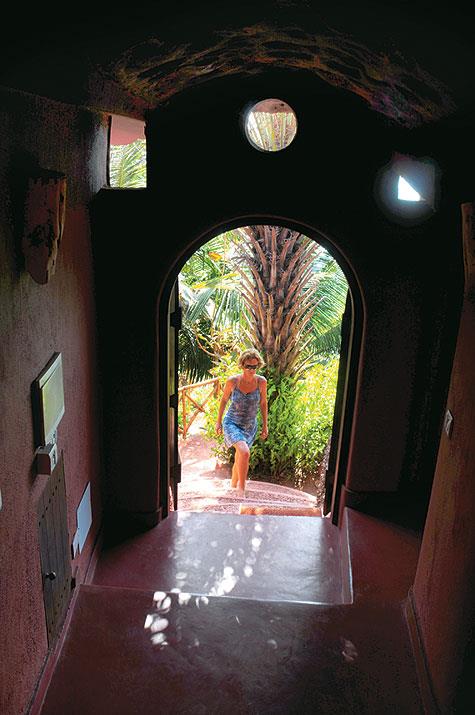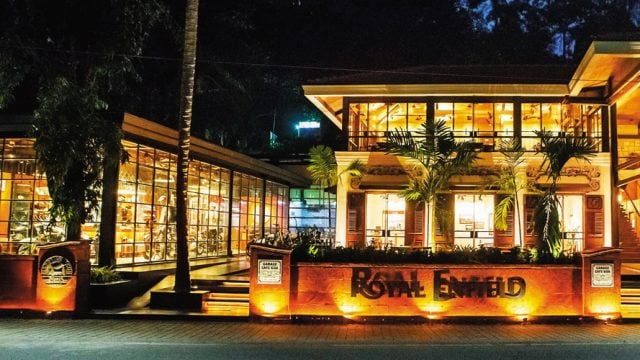The Hobbit? Go through the Anjuna flea market, you’ll come to a hill on the beach, and
I have Tolkien for company, with the first lines from The Hobbit running through my head: “In a hole in the ground there lived a hobbit. Not a nasty, dirty, wet hole, filled with the ends of worms and an oozy smell, nor yet a dry, bare, sandy hole with nothing in it to sit down on or to eat: it was a hobbit-hole, and that means comfort.”
The carved dragon on the small sign outside the door winks at me as I walk in and stop dead. It doesn’t matter what you’ve been expecting when you first see The Hobbit — stepping in is like stepping into a hotel from fantasyland.
There’s a flight of steps cut from stone that goes up and down and almost sideways. There’s a comfortable nook with large windows that look out onto the broad white roof and a row of cheerfully waving palm trees. There’s a fanciful spider’s web made of knotted rope (but no resident arachnid), a mosaic snail, and an almost dwarf-sized pregnant black cat with bewitching green eyes looking up at me in plaintive greeting. (This last is just visiting.) There are walls that take on the shape of the cliff, with the natural laterite rock projecting into the rooms at one point, ferns growing out of a section at another, and the rest covered with funky bubbles in the colours of the beach and the ocean. There’s a stunning garden that flows all the way down the cliff until it bumps into the beach proper, filled with palms, young chili plants, ferns and hammocks. And there’s Chinmayi, owner and restorer of The Hobbit, offering hospitality, stories about the history of the area and a guided tour all in one breath. (As Tolkien remarks astutely, hobbits are fond of visitors.)
Ten minutes later, I’m washing off the dust of the journey in a beautifully appointed bathroom (large, soft fluffy towels, yellow Jaisalmer stone for the basin) where the shower stall is, literally, carved from the cliff, and where you can see the sea from the window. There’s a plunge pool, tiled in blue, just outside the steps from my room that lead onto the white, cushion-friendly roof, and later, I’ll lie back with a good book and watch a lone paraglider navigate the skies, as dogs play far down on the beach.
Chinmayi’s bustling around in the airy, inviting drawing room that the residents of The Hobbit’s three rooms can repair to when the whirl of raves, beaches, and general pigging out becomes too exhausting. While The Hobbit doesn’t have its own kitchen, Chinmayi and her husband also own Shiva Valley, the shack at the bottom of the garden. For those too immersed in the spirit of susegado to take the winding flight of steps down to the shack, the ‘house boys’ will bring your meals up to the house, and on request, Chinmayi will stock the fridge with cold drinks, beer, wine and snacks.
We settle down; piles of cushions make the yellow sandstone sofa so comfortable that I instinctively put my feet up — it’s that kind of house.
St Michael’s vaddo is off to a side from Anjuna proper, and The Hobbit nestles in a quiet cove — near the mayhem, but not of it. Even the twice-weekly raves are relatively sedate, compared to what you might find at the more twisted heart of Anjuna.
“Once upon a time,” David Tomory writes in Hello, Goodnight, his classic history of Goa, “there had been naked hermaphrodites to astound the fully dressed men. The mobile Californian commune called the Hog Farm had visited. There was at least one Family of unrelated adults; there were the Green People, each bearded patriarch marshalling his wives and babies.”
Today’s seekers, mavens and mavericks are of a different breed. Some, like the older residents who’re Chinmayi’s friends, will demand their privacy — or charge a fee — in exchange for telling you stories about the mansion called Orgasmic and the mellow beatnik days. Chinmayi and her husband bought The Hobbit 10 years ago from a retired hippie who’d run out of steam and cash.
“It was psychedelic. There was a row of hammocks hanging from the roof, the rocks on the walls were psychedelic, the floor was psychedelic and the windows were tiny slits. There was no running water, just the two wells; he used what’s now the plunge pool as a bathroom. The exterior was made of shells and pebbles, but we had to change that too — it retained heat and attracted too much dirt. And you can’t live with psychedelic every day.”
Chinmayi enlisted Arvind D’Souza to do the renovations, and he came up with this “stark, beautiful” framework, leaving the natural rock in as part of the Cudappa stone walls, installing the Jaisalmer stone beds and sofas, using earth colours and quiet shades. “It was gorgeous — but almost too stark. This is a funky house; I wanted it to be bohemian. There’s this Israeli guy on Vagator Hill, a tattoo artist, so he knows what to do.” The first few years, the walls were spray-painted in a floral pattern; this year it’s bubbles, Chinmayi’s only brief being that purely natural shades should be used.
Bubbling away as she suggests walks (“up the hill, great for bird-watchers”), excursions (“there’s a nice fete hosted by the Church this evening”), things to do (“an awesome yoga place — or there’s a rave on tonight on the beach”), Chinmayi makes up the best part of The Hobbit — it’s like having a good, local friend who’ll help you feel less of a tourist.
Below on the beach, a muffled beat starts up. In season, the sea outside is blue, glassy and calm; the raves are more intense, more fierce, the famous flea market seething with promise. But this is the end of season, and everything’s laid-back — even the music.
Chinmayi comes out to one of the balconies attached to each of the three rooms. “South Anjuna used to be a hidden cove,” she says. “One of the earlier, legendary hippie communes was here. The Magic Bus from Amsterdam, the Californians; this was their beat. There were moonlight parties; The Who dropped by and played over there, on that property — see? It was the happier side of the hippie dream; you could walk around naked on the beach. It’s only recently that the locals have started to use it. Before that, it was the other guys, like the Spaniard who walked around in a leopard skin and cut his hash with a machete.”
I like the inside-outsideness of the house, and the up-and-downness too. It’s the kind of place where you expect to bump into Mr Underhill or a clan of Bagginses around every corner. Having just three rooms ensures that this is perfect for small groups — like-minded friends, a large family.
Nervous parents, the vertiginous (the house is built on several levels) and the very formal would be best advised to stay away from The Hobbit, though. The lack of stair railings and the bumpy walls make it a hazard for children, though some kids love the whimsy of the place. And the ‘koi hai’ brigade, used to trembling bearers and formal dress for dinner, would retreat bewildered in the face of The Hobbit’s casual, anything-goes charm. Chinmayi insists that she’s much more formal these days: “I’ve stopped wearing my lungis when guests arrive — and I even put on my chappals when I greet them.”
Swimming in a pristine sea the next morning, I come back to shore with a veritable guard of honour — two boisterous dogs who’ve played catch in the waves with me as the ball, and the early fishing boats. This is one way to “do” Anjuna, by not doing it at all. Take the house advice, and go to the local places for awesome fish curry-rice or rawa mussels — Anand’s is buzzing, and Zoorie’s does great steaks. Ask the fishing fleet what you should have for lunch, birdwatch, walk, paraglide, snooze on the roof, drive to Mapusa market for red chillies, fresh curry pastes, cashews, and dodol and bebinca at Simonia’s.
Or join the last, ragtag remnants of the hippies, with a nostalgic look at the raves and the peaceful smokers at Shiva Valley, work your way through the flea market and through Basilico’s incredibly fine Italian menu, party at any of 15 different bars and pubs. Whatever works for you.
Me, I have to leave for Delhi, dragging myself out of this Tolkien-inspired fantasy. Rarely has a house lived up so spectacularly to its name — and some of its magic follows me to the airport. Unwittingly echoing Smeagol in The Hobbit, the security lady asks me: “What have you got in your pocket?” I check. A (wrapped) beef croquette from Xavier’s bakery, two seashells, a pebble painted in rainbow colours, some white sand. Nothing I’d call “my precious”, except for an invisible fistful of memories.
The Hobbit
where to stay in Anjuna Beach
Leave a Reply
You must be logged in to post a comment.





